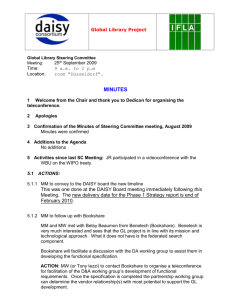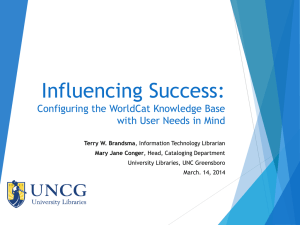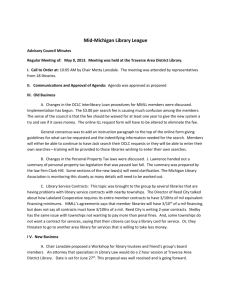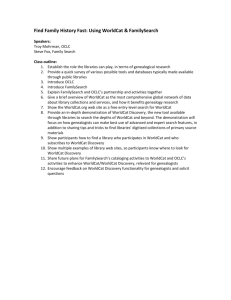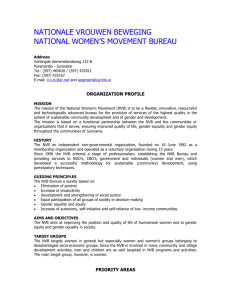1 Libraries and their catalogues as sources of information
advertisement
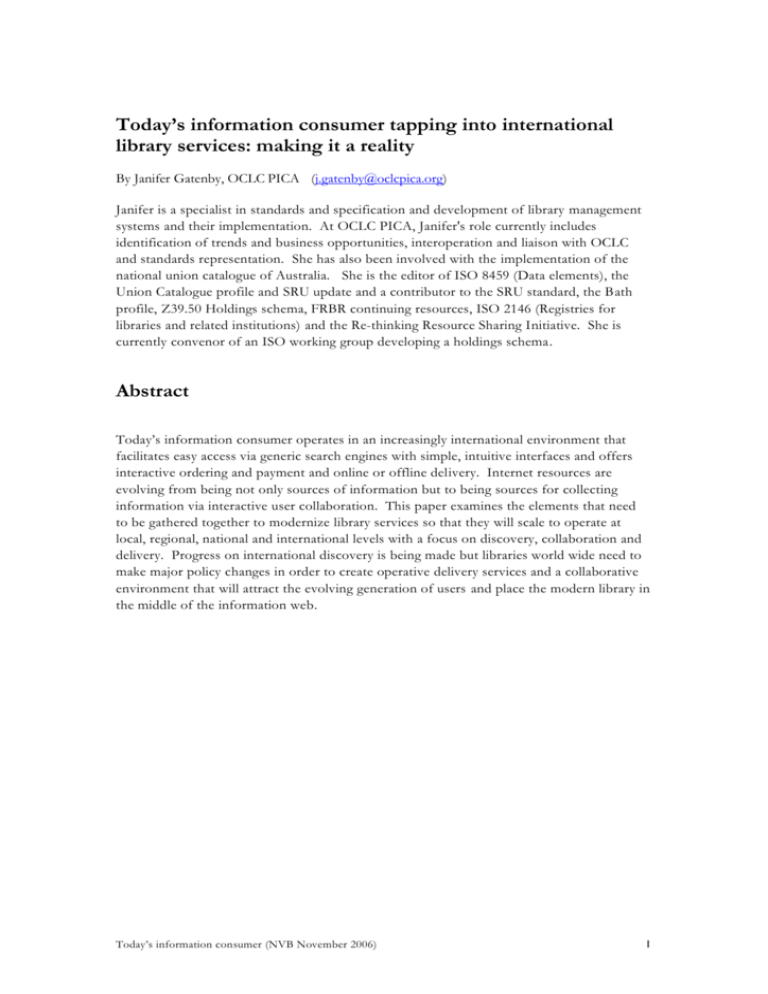
Today’s information consumer tapping into international library services: making it a reality By Janifer Gatenby, OCLC PICA (j.gatenby@oclcpica.org) Janifer is a specialist in standards and specification and development of library management systems and their implementation. At OCLC PICA, Janifer's role currently includes identification of trends and business opportunities, interoperation and liaison with OCLC and standards representation. She has also been involved with the implementation of the national union catalogue of Australia. She is the editor of ISO 8459 (Data elements), the Union Catalogue profile and SRU update and a contributor to the SRU standard, the Bath profile, Z39.50 Holdings schema, FRBR continuing resources, ISO 2146 (Registries for libraries and related institutions) and the Re-thinking Resource Sharing Initiative. She is currently convenor of an ISO working group developing a holdings schema. Abstract Today’s information consumer operates in an increasingly international environment that facilitates easy access via generic search engines with simple, intuitive interfaces and offers interactive ordering and payment and online or offline delivery. Internet resources are evolving from being not only sources of information but to being sources for collecting information via interactive user collaboration. This paper examines the elements that need to be gathered together to modernize library services so that they will scale to operate at local, regional, national and international levels with a focus on discovery, collaboration and delivery. Progress on international discovery is being made but libraries world wide need to make major policy changes in order to create operative delivery services and a collaborative environment that will attract the evolving generation of users and place the modern library in the middle of the information web. Today’s information consumer (NVB November 2006) 1 1 Libraries and their catalogues as sources of information Librarians long had the position of collectors and curators of information but recent history has seen this domain flung wide open on the web. Google (http://www.google.com), Yahoo (http://yahoo.com), Microsoft (http://www.msn.com/) and other search engines have set the standard for simple searching, offering simple input, interpreted natural language searching, spell checking, intuitive relevance ranking and moreover large, comprehensive data sets. A survey of college students in the U.S., U.K., Canada, Australia, Singapore and India indicated that 89% of them use search engines as a first resort (OCLC 2005); statistics that surprise nobody. Moreover, for information about books, users are as likely or more likely to visit Amazon (http://www.amazon.com) because it offers easy intuitive searching and data which is more attractive than that traditionally offered by library sites including not only cover art but in particular reviews and ratings contributed by the book industry and individual visitors to the site. The ubiquitous use of search engines poses questions on whether library catalogues and portals are needed, and if needed what is their role? Where do they add value? Originally the main justification was that the collections of libraries were represented in databases that were not accessible via the search engines, neither books, nor the articles within journals, nor other forms of material, whether digital or physical. But now this is less valid as Google, Yahoo and Microsoft are involved in massive digitisation projects and harvest records from publishers. The main role for library catalogues and portals will be to connect users with resources, whether owned, licensed or recommended, physical or digital and thence to facilitate eventual delivery. To play this role, the catalogues must be readily accessible from the points that are most widely used, i.e. search engines and sites with bibliographic data such as bookshops and encyclopaedias. 2 Exposure Exposure of library catalogues on the web in general used to be limited to simple URLs or at best, a simple search bar in a parent organisation web page. This is no longer ideal; it is important that users can access libraries’ catalogues from items already found without having to search again for them. With specific entry, users are not only reminded of availability in libraries, they are offered associated reference and delivery services and can then take the opportunity to search and browse further. 2.1 Exposure by making data harvestable In 2004, OCLC led the way with the Open WorldCat project (http://www.oclc.org/worldcat/open/default.htm) by offering harvestable metadata to Google, Yahoo, Microsoft, Ask.com, online bookshops and selected other bibliographic web sites. The aim of the project was to make library resources more visible on the web and to publicise the services of the libraries associated with the resources, particularly delivery and Today’s information consumer (NVB November 2006) 2 reference services. Figures for April 2006 indicate the resounding success that this project has achieved. Open WorldCat Usage Statistics for April 2006 Total referrals to Open WorldCat 5,290,251 Average daily searches 176,342 Referrals from Yahoo 2,086,548 Referrals from Google Scholar & Google 1,046,050 Links to library services 164,979 Daily average identifier links (ISBN, OCLC number, etc.) to OWC in May 2006 28,000 This successful project was followed in August 2006 by the release of the public web site worldcat.org. WorldCat.org (http://www.worldcat.org) provides a permanent destination page and search box that allows more specific searching of the entire WorldCat database, numbering more than 70 million records and 1,000 million holdings from more than 54,000 libraries on 1 st August 2006. Concurrently with the open WorldCat project, OCLC and OCLC PICA launched a drive to strengthen the international content of WorldCat by loading national and regional union catalogues. As a result union catalogues from the Netherlands, Finland and United Kingdom (public libraries) have been loaded and several from Germany and Poland are in process with many more in various stages of negotiation. One major benefit is the coordinated web exposure, leading directly via “click-through” to the actual item in the closest local catalogues for availability or to a local resolver for access to electronic items. By loading through WorldCat, the world’s library holdings are consolidated in a single entry in the search engines such that the record deserves a high ranking by the search engines. Were libraries to load individually to search engines, not only would the administrative burden be unnecessary, it would be counter-productive, putting a library’s entries in competition with those from other libraries and probably resulting in low ranking for all. The importance of maximizing page ranking should not be under-estimated as results beyond page 5 are generally not accessed. Moreover, OCLC’s experience is that there is an ongoing need to negotiate with the search engines to ensure timely and complete load with maximized relevance. Today’s information consumer (NVB November 2006) 3 Figure 1: A sample page from Open WorldCat 2.2 Exposure by web browser plug-ins and bookmarklets Web browser plug-ins and bookmarklets offer relatively new ways to attract users to library resources. The plug-in or bookmarklet could be offered and promoted to the user on registration or available by download from library and union catalogue web pages. The advantage of these devices is that they will operate on any web page accessed by the user without any prior negotiation with the creators of the page. One example is OCLC’s Office of Research xISBN (http://www.oclc.org/research/projects/xisbn/) that detects ISBNs on a web page (e.g. bookshop) and produces a list of related ISBNs that can be imported into a search of a local or union catalogue. The Rethinking Resource Sharing Initiative has produced a specification for a similar plug-in, “get it”, that would be used to bring user requests into a local resolver, or cooperative resource sharing system. This kind of function must work with screen scraping techniques which are inherently error prone. A promising alternative to screen scraping is the COinS specification (Hellman 2005) that indicates how web site administrators can ensure that bibliographic data can be captured in a standard way using the HTML span element. The aim is that a user, no matter where he or she is on the web, can quickly and easily check libraries as alternative sources for information. 3 Library catalogues and portals – search and presentation As library catalogues, union catalogues and portals are accessible from web sites, they need to follow well accepted web designs in their interfaces and work flows. On examination it is clear that substantial improvements are needed to searching, presentation, content and to the ways that the user may interact. Today’s information consumer (NVB November 2006) 4 Libraries are starting to respond to the challenge created by the Google searching experience. On the searching side, most systems now offer simple single search boxes, but natural language searching and spell checking are not yet ubiquitous. Without these two features even known item searching can be compromised. Andrew Pace from North Carolina State University lists searching other than for known item, searching other than for books and journals and lack of faceted browsing1 as common serious weaknesses (Pace 2006). Improvements to presentation are also evident ranging from display of cover art and table of content data (inspired by Amazon) to ranking result sets by relevance. 4 Enriched metadata Whilst on the one hand taking interface, searching and presentation lessons, librarians are examining areas where their catalogues can add real value that is not within the (current) capability of the search engines and other sites. Once attracted to a library or union catalogue, the user should be able to browse and navigate in better ways, use rich evaluative information to enable selection and to network with fellow researchers and information seekers. Our online catalogues need to become as attractive and usable as our buildings and physical collections, offering “virtual shelf browsing” and interaction with colleagues. Maness (2006) stated “the face of the library’s web-presence in the future may look very much like a social network interface.” 4.1 Improved grouping by works This includes improving manipulation of result sets beyond relevance-ranking, notably by grouping works together logically using the FRBR model (IFLA 1998). Employment of the concept can also allow retrieval of all editions from any one edition, thus improving search and navigation capability. Yet, there have been relatively few implementations of FRBR since its publication in 1998 and it is the general consensus that if FRBR is going to fly it must be possible to achieve it without a huge retrospective cataloguing conversion program. Thus there have been some algorithms produced to create FRBR work records, among them the freely available one from the OCLC Office of Research (Hickey 2003). The algorithms have been employed in systems that create FRBR work records on the fly but this is inefficient, and not ideal for detecting merge failures and correcting them. Correcting merge failures is usually achieved by creating an authority record or correcting bibliographic data. Obviously this is ongoing work that OCLC is well positioned to achieve, and the larger the bibliographic and authority database used for creating and maintaining the work records, the more reliable those work records will be. OCLC and OCLC PICA are cooperating in a project to employ the work data derived from WorldCat using the OCLC Office of Research FRBR algorithm. As a result of having loaded the Dutch national union catalogue into WorldCat, it is possible to extract a subset of work level data for incorporation into the displays of the union catalogue. Results from this project are due in October 2006. The approach is a "divide and conquer" solution where Faceted browsing (or searching) enables multiple headings and sub headings to be broken into components so that they can be searched independently or re-combined with other search terms. 1 Today’s information consumer (NVB November 2006) 5 OCLC is responsible for the creation and maintenance of the work records that it can provide to other systems that then occupy themselves with loading and display aspects. 4.2 Improved authority control Authority data has enormous potential to intuitively improve precision in searching, comprehensive recall and navigation and to improve presentation. There are many current projects that attempt to improve the creation and diffusion of authority records. Among these are three notable successes: The Virtual International Authority File project (Bennett 2006) is a joint venture of the Library of Congress, Deutsche Bibliothek and OCLC. The project links authority records from the three organisations, creating a multi-entry search facility allowing users to search all resources by their language, script and spelling preferences. The Digital Author Information (DAI) project (http://www.rug.nl/bibliotheek/informatie/digitalebibliotheek/daikort?lang=en) is a Dutch national project that aims to allocate unique national identifiers (DAI numbers) to each author associated with a Dutch university or research institute in order to enable complete and accurate selection of an author’s publications. The system is maintained within the name authority file of the national union catalogue at OCLC PICA in the Netherlands and serves as a link between the registration tool of researcher activities, the library catalogue and the repositories of electronic publications. In Australia, in 2000, the Australian Literature Gateway (http://www.austlit.edu.au/about) was launched. “AustLit is a non-profit collaboration between ten Australian Universities and the National Library of Australia providing authoritative information on hundreds of thousands of creative and critical Australian literature works relating to more than 75,000 Australian authors and literary organisations.” This site is particularly interesting for several reasons: o It was one of the first implementations of the IFLA data model Functional Requirements for Bibliographical Records (FRBR), based on the work rather than the manifestation o Equal emphasis is given to authors and works with enriched author records including rich biographical information and thumbnail portraits o The data was made in collaboration with university academics who were able to “sign” definitive lists of authors’ works 4.3 Evaluative criteria There is also great potential to improve searching, evaluation and delivery by new evaluative criteria, such as derived audience level, rareness and copyright status estimation. OCLC researchers (Lavoie 2006) are mining WorldCat for information and combining it wi th data gathered from other sources such as circulation transaction logs and history files, reference service data and ILL transactions to produce such enriched information. Today’s information consumer (NVB November 2006) 6 The enriched metadata pool of the future will be achieved via several contribution channels: o from traditional cataloguing, o from automated extraction from electronic resources, automated classification and subject heading assignment (Dempsey 2004-2005) o from ratings created by evolving algorithms, o from loading and linking external data, e.g. lists of prizes, course reading lists and professional reviews o and from user contribution. Inviting public contribution will not change the librarian’s role but will add an editorial element to it. 4.4 Collaboration and user interaction Collaboration is the area that is probably the most challenging to traditional library thinking. It is now time to regard collaboration as a means both to engage users and to maximize the use of library resources by enriching the metadata, making it easier to search and browse and more informative when it is retrieved. Acceptance of user collaboration has the potential to change and improve traditional cataloguing and resulting library services just as cooperative cataloguing did in the 1960s and 1970s. Using collaboration, libraries can potentially foster an exciting environment where library metadata resources can be reused by end users for creating their own personal catalogues with annotations (e.g. things I’ve read or will read, lists for papers), sharing these with peers and colleagues, or can be used as an authoritative source of personal publications for citation in curriculum vitae and resumes. In addition to reusing the data, users can enrich the publicly available data with reviews, links and even biographical information in authority records. “Users could tag the library’s collection and thereby participate in the cataloguing process” (Maness 2006). Examples of collaborative contribution abound on the web. In addition to Amazon, the most quoted sites are: o flickr (http://www.flickr.com/) a site now owned by Yahoo where users are able to load and share their annotated photographs o wikipedia (http://www.wikipedia.org), an encyclopaedia made by user contribution o wikiquote (http://en.wikiquote.org/wiki/Main_Page) o del.icio.us (http://del.icio.us/), a site where users can store, annotate and share their bookmarks New sites are appearing rapidly such as: o o o o genesreunited (http://www.genesreunited.co.uk/) - at 1st August 2006 over 75 million genealogical records loaded by users hoping to find others with common ancestors geograph.org.uk (http://www.geograph.org.uk/) This is a site where the public are invited to provide a photo for every square mile of the United Kingdom. librarything (http://www.librarything.com) where users can catalogue their own collections and meet others with similar reading habits BBC annotatable audio project (Coates 2006). “An experimental internal-BBC-only project designed to allow users to collectively describe, segment and annotate audio in a Wikipedia-style fashion.” Today’s information consumer (NVB November 2006) 7 Figure 2: BBC Annotatable Audio Maintenance Screen OCLC’s Worldcat.org includes, among other features, the possibility for user contributed reviews. As more and more users discover this site they will be attracted to add their reviews opening the opportunity for other forms of contribution to be solicited. There are other initiatives at the national level. The National Library of Australia announced in 2006 cooperation with Yahoo to allow users from the Flickr site to populate Picture Australia (http://www.pictureaustralia.org/). The image below is an example of a photograph contributed this way, showing a different view of a common scene. Today’s information consumer (NVB November 2006) 8 ‘Giraffe surveys the Sydney skyline’ photo by Ben Harris-Roxas Figure 3: User contributed photograph to Picture Australia The potential of user contribution is exciting, or perhaps this should be stated more strongly: user contribution is essential to the future relevance of library data and resources. It is only by opening up contribution in this way that library metadata pool will be rich enough to satisfy the growing requirement for sifting the best or most appropriate from large result sets and navigating among the best. Moreover, users return to sites where they feel part of the club. User contribution will not happen automatically; making a contribution needs to be attractive and easy. Users will be more encouraged to contribute reviews and annotations to a site that already has some evaluative content, so it would be ideal to first load reviews, awards and such like from authoritative sources. Users need to be wooed by attractive sites and intriguing challenges, flattered with acknowledgments and courted with work flows designed to fit with their habits. Contrast the laments about the poor contribution rate to institutional repositories (Kim 2006) with the statistics from web sites such as geograph.org.uk (http://www.geograph.org.uk/statistics.php). Between March 2005 and August 2006 there were 201,365 contributions with a current contribution rate between 3,000 and 4,000 a week. 5 Delivery Internet services are creating expectations that libraries must heed. Users can tap into international resources, enrol online or remain anonymous as appropriate, order and pay online with either instant online delivery of electronic resources or delivery of physical resources to an address nominated by the requestor. Today’s information consumer (NVB November 2006) 9 Delivery models of note are: o o o o o o amazon (http://www.amazon.com/). This site and many, many more like it enables online registration and credit card payment with home or other delivery, world-wide for most materials eBay (http://ebay.com). This second hand market advertises goods on behalf of sellers and facilitates secure credit card payment between buyers and sellers using PayPal (https://www.paypal.com/cgi-bin/webscr?cmd=xpt/bizui/WhatIsPayPaloutside ) netflix (http://www.netflix.com/HowItWorks?lnkctr=nmhhiw). This site claims the most comprehensive selection of DVDs and offers lending services with no due dates, free delivery and free return using pre-paid envelopes Victoria Birth, Deaths and Marriages (http://online.justice.vic.gov.au/servlet/bdm_home). Like many similar sites, it is possible to search, order and pay for certificates online and receive either digital images or hard copies. read it swap it (http://www.readitswapit.co.uk/TheLibrary.aspx) is a UK based site facilitating book exchange between individuals, relying on personal ratings Cumberland lookup exchange (http://www.geocities.com/Heartland/Hills/6401/Cumberland/lookup.html) is a list of individuals providing free consultation services to resources related to Cumberland genealogy. Communication is via email. Of these sites, all except two will provide international request and delivery services . Only Netflix (U.S.) and Read it swap it (U.K.) have geographic restrictions and these are at a national level. There is a lot to do before library delivery services can proudly stand alongside these listed above in terms of ease of requesting and delivery. Gatenby and Goldner (2005) gave this warning: “We now have a situation in which users may discover items in online indexes or online library catalogues then hit a dead end as far as delivery is concerned. This is a dangerous situation for the role of libraries in general. If libraries collectively do not seek to find ways to get around these dead ends others will.” (p. 186) On both sides of the Atlantic, groups are beginning to form with a view to improving delivery: In the U.S., the Rethinking Resource Sharing Initiative formed in 2005 with a section on user needs, another on policies and a third on technical inter-operability. The biggest changes are needed in the policy area. Their manifesto produced in 2006 stated: “As libraries are making their collections visible on a global scale, so should they provide an international resource delivery system or a service model that combines the strengths of all participating libraries.” (p. 1) Dempsey (2006) also highlights the unsatisfactory “patchwork” nature of discovery to delivery and assets that inter-library loan rates are too low. 2 10% of books account for 90% of circulation, indicating that the majority of items in libraries are underused. Policies of individual libraries do not encourage use of little used materials by people outside the library’s constituency. Libraries should offer some service, either by loan or digitis ation on demand, or by copying the table of contents and index or by offering a reference look up. Requests should contain notes fields that allow users to explain why they are asking for an item. For example “hoping that it contains an image of Ross Bridge around 1920”. It is 2 He recommends central storage as a solution to widen usage, decrease costs of distribution and ensure preservation. Today’s information consumer (NVB November 2006) 10 better to offer service at full administrative cost with even an overhead than to refuse outright. Also in 2006, the European Library Automation Group (ELAG)’s working group on resource delivery reported on the elements needed for an international framework, largely affirming the recommendations of the “Rethinking Initiative” including: o o o o o o online registration unmediated end user requesting and delivery with library’s mediation in authentication, payment and as a depot for return more delivery options, including digitisation on demand, purchase and links with reference services for look up service inclusion of contextual information in requests including indications of rareness, likelihood of copyright expiry so that appropriate options can be proposed and refusals can be evaluated for impact charging instead of refusing cooperating with archives to provide seamless services The ELAG working group noted some best practices in Europe that could serve as models for the rest of the world in the areas of unmediated requests and digitisation on demand. 5.1 Unmediated user requests: New models for resource sharing that empower users to make their own requests online for the materials that they have found need to be seriously considered. Rather than “ask your library to get it for you” that implies success is not certain, our user interfaces should allow direct requests, not mediated suggestions. In the Netherlands, users can establish personal deposit accounts via their library to cover loan and copy transactions. Via the PiCarta service (http://oclcpica.org/content/11/pdf/picarta_uk.pdf), users can place requests directly, after first accepting or editing a prioritorised list of libraries generated by the system according to multiple criteria such as cost, proximity, expected delivery time etc. The requested items are then delivered to the user’s library. In Germany, the mediation is taken one step further where both loan and non returnable copies are sent by publicly funded libraries directly to the user’s nominated address. The table below indicates the ideal role that should be played by librarians in request transactions, i.e. positive mediation and not mediated. Registration Authentication Intrusive, unnecessary mediation Manually in library or online with pickup of card in the library repeated challenges and challenges for freely accessible materials Positive mediation Not mediated Online registration with email confirmation Online registration, or no registration authentication and authorisation facilitating access unmediated – no challenge for freely accessible materials Today’s information consumer (NVB November 2006) 11 Request process Intrusive, unnecessary mediation mediated by librarian, approves and selects locations Payment user required to pay in the library building Delivery to library, user must visit Return not applicable Positive mediation Not mediated Program algorithm proposes locations in order of preference Program processes rota behind the scenes Paid by library subscription User establishes deposit account with library for online use library received but then forwards to user address not applicable via closest library or any library user pays per request via PayPal etc. direct to user nominated address – home, office, email, or URL within email Direct return or no return 5.2 Digitisation on demand Led by the University Innsbruck library and supported by the eTEN programme, the DoD (digitisation on demand) project (http://www.uibk.ac.at/ub/dea/eten/) aims to make millions of books published between 1500 and 1930 from 13 major research libraries and 8 countries available on request as e-books. 5.3 Making the process simple and scalable Initiatives like Open WorldCat are resulting in successful exposure of library resources on the web. This needs to be followed rapidly with an efficient and scalable delivery system. Some of the components that are still needed are: o A change in library policies to increase the delivery options and to increase the service to non constituent users o A simple means of transferring information about requests to delivery systems. The Request Submission Message (http://oclcpica.org/?id=1409&ln=uk) is currently being edited as a set of openURL schemas and registered with the NISO openURL maintenance agency. This standard could be the backbone of the “get it” button such as proposed by the Rethinking Resource Sharing Initiative. An international library policy registry for use by all delivery systems A simple means of paying library to library across delivery systems Ability of delivery systems to accept payment direct from end users in user interfaces of delivery systems using such methods as PayPal Coordinated resolution services Simple, effective communication among delivery systems o o o o o Today’s information consumer (NVB November 2006) 12 In the rush to link users with licensed digital full text, the physical collection must not be overlooked. It is delivery from the physical collections on a world-wide scale that is the most challenging. 6 Conclusion The table below indicates a check list of items that are required to make a workable library resource service framework. Library resource service framework: shopping list Exposure Exposure of resources Search engines Web sites with bibliographic data – bookshops, online journals Parent body web sites Archives web sites International and national union catalogues Discovery Interfaces Discovery Natural Language Spell checking and suggestions Authorities – multi-lingual Authorities – biographical links Authorities – repository links Authorities – wiki capability to add data for CVs, creation of definitive bibliographies Result set Relevance ranking Date, language, format etc. Presentation Cover art Clustering (FRBR works) Links (externally) to bibliographies and reading lists, encyclopaedias, biographies, union catalogues Links (internally) to related works, other editions, authorities Evaluation Table of contents, abstracts, summaries Reviews (publisher and user contributed) Rareness / Popularity indication Recommendations (circulation and reading list information) Audience level (derived by data mining) User interaction Re-use, copy, annotate, share Contribute Resource Delivery Systems Delivery End user unmediated requests Online registration Today’s information consumer (NVB November 2006) 13 Library resource service framework: shopping list Presentation of all appropriate delivery options Simplified payment Discover locations Indicate reason for request (where lookup could be a substitution for loan) Indicate rareness (request context) Indicate copyright likelihood Integrated work flow – operate on local, regional and international levels It is clear from this list that achieving this will require cooperation among libraries , union catalogues and their system providers to a significantly increased degree. Miller (2006) draws the same conclusion. Ideally, metadata should be shared, exposed and made available at an international level. Enriched data also should be collected and exposed internationally unless it is specific to a particular locality. Even so, data may be created locally, regionally or internationally; what is important is that it is collected together. Successful user collaboration is most likely to happen with critical mass and that implies a web site with a large international presence such as worldcat.org. Services, such as reference and delivery services operate at local, regional, national and international levels and must inter-operate to enable referral and escalation of requests. They need to rely on metadata and central registries to determine optimal services in specific instances. To achieve system improvements at all levels to match successful models on the web at large, services such as access to cover art, OCLC’s xISBN and FRBR data service are emerging. Much more can be achieved through similar simple services that maximise the re-use of data or provide data manipulations. Local systems will increasingly derive enhanced displayed data via calls to external databases. Inter-dependence of systems and services is becoming increasingly evident. Gone are the days when the integrated library system was the prime point of entry with external communication limited to bookshop orders and enquiry in and out via Z39.50. Now not only do systems derive data for their main displays from external sources, they are experiencing a growing proportion of accesses coming from external systems. The local system’s resolver is moving from the back door to the front door. With external data exposure and improved inter-operating services, libraries can predict significant increases in specific accesses to their catalogues. Once in the catalogue, these users will discover the powerful browse, navigation and result set manipulation features, rich data that assists evaluation and a means to communicate with peers. This new trio: browse/navigation, evaluative content and social networking coupled with improved delivery will ensure sustained usage of our catalogues into the future. Today’s information consumer (NVB November 2006) 14 7 References Bennett, R., Hengel, C., Hickey, T., O’Neill, E. and Tillett, B. (2006) Virtual International Authority File: [presentation to] ALA June 2006. Retrieved August 1, 2006 from: http://www.oclc.org/research/projects/viaf/ala2006c.ppt#331 Dempsey, L., Childress, E., Godby, C.J., Hickey, T., Houghton, A., Vizine-Goetz, D. and Young, J. (2004-2005). Metadata switch: thinking about some metadata management and knowledge organization issues in the changing research and learning landscape. Forthcoming in LITA guide to e-scholarship, ed. Debra Shapiro. Retrieved August 1 2006 from http://www.oclc.org/research/publications/archive/2004/dempsey-mslitaguide.pdf Dempsey, L. (2006). Libraries and the long tail: some thoughts about libraries in a network age. D-Lib Magazine, 12 (4). Retrieved August 1, 2006 from http://www.dlib.org/dlib/april06/dempsey/04dempsey.html ELAG working group on resource delivery (2006) Report to ELAG 27 th April 2006, Bucharest, Romania. Retrieved August 1, 2006 from: http://oclcpica.org/content/1400/pdf/ELAG2006-WGonResourceDelivery.pdf Gatenby, J. and Goldner, M. (2005) International sharing and delivery of library resources. Interlending and document supply. 33(4), 184-188. Hellmann, E. OpenURL COinS: A convention to embed bibliographic metadata in HTML. Retrieved August 1, 2006 from: http://ocoins.info/ . Hickey, T. and Toves, J. (2003) FRBR work-set algorithm. Retrieved August 1, 2006 from http://www.oclc.org/research/projects/frbr/algorithm.htm IFLA (1998) Functional requirements for bibliographic records. München: K.G. Saur Kim, J. (2006) Motivating and impeding factors affecting faculty contribution to institutional repositories. Retrieved August 1, 2006 from http://sils.unc.edu/events/2006jcdl/digitalcuration/KimJCDLWorkshop2006.pdf Lavoie, B., Dempsey, L. and Connaway, L.S. (2006). Making Data Work Harder. Library Journal (January 15, 2006). Retrieved August 1, 2006, from http://www.libraryjournal.com/index.asp?layout=articlePrint&articleid=CA6298444 Maness, J.M. (2006) Library 2.0 Theory: Web 2.0 and its implications for libraries Webology 3 (2). Retrieved August 1 2006 from http://www.webology.ir/2006/v3n2/a25.html Miller, P. (2006) Coming together around Library 2.0: a focus for discussion and a call to arms. D-Lib magazine, 12 (4). Retrieved August 1, 2006 from http://www.dlib.org/dlib/april06/miller/04miller.html OCLC (2005) Perceptions of libraries and information resources: a report to the OCLC membership. Retrieved August 1, 2006 from http://www.oclc.org/reports/pdfs/Percept_pt1.pdf Today’s information consumer (NVB November 2006) 15 Pace, A. K. (2006). Dis-Integrated Library Systems and the Future of Searching, Amigos Annual Meeting, 2006, Dallas, TX. Retrieved August 1 2006 from http://www.lib.ncsu.edu/presentations/2006Amigos/amigos.ppt Rethinking Resource Sharing Initiative – Policy and Cultural Issues Group (2006) A manifesto for rethinking resource sharing . Retrieved August 1, 2006 from http://www.ala.org/ala/rusa/rusaourassoc/rusasections/stars/starssections/committeesa/rrsco mm/RRSManifesto16June06.doc Rethinking resource sharing blog. http://blog.aclin.org/ Accessed August 1 2006. Today’s information consumer (NVB November 2006) 16
